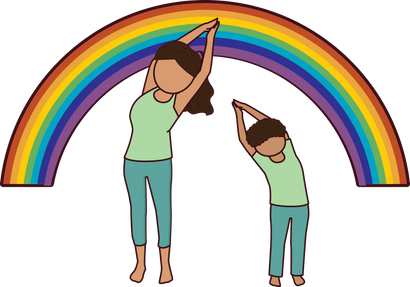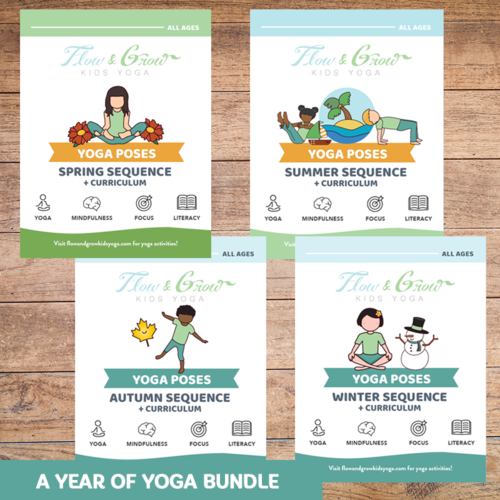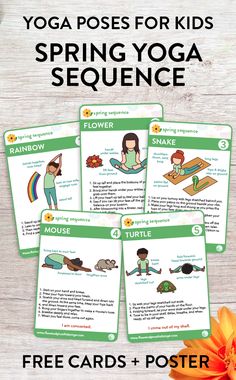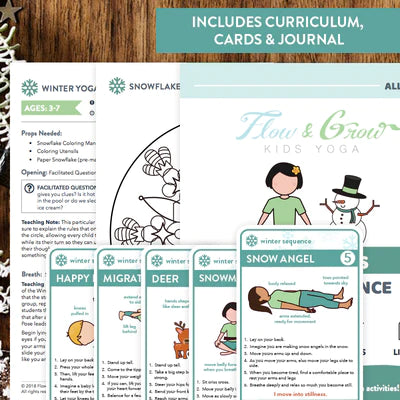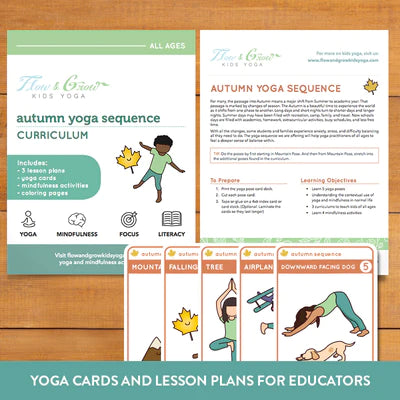Your Cart is Empty
22% off Automatically at checkout when you spend $5 of more!
22% off Automatically at checkout when you spend $5 of more!
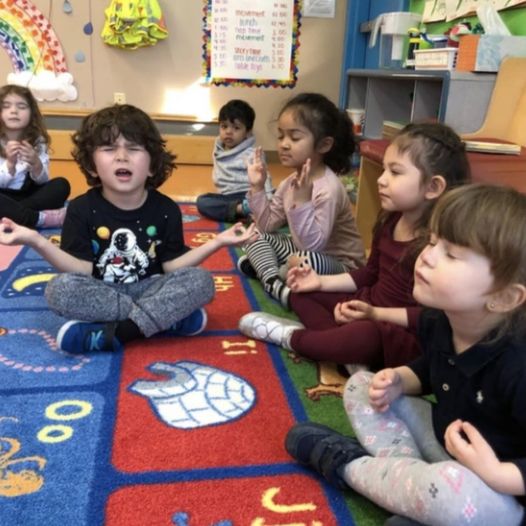
4 self-care tools for students: boost academic performance, pro-social behavior and much more
by Lara Hocheiser August 21, 2021 4 min read
By Lara Hocheiser, Flow and Grow Kids Yoga Founder/Owner and Kathryn Boland, Flow and Grow Kids Yoga Blog Manager

Though opinions of educators, administrators, parents, and enrichment staff can differ, we all want the same thing for the kids in our lives -- we want them to do and feel their best.
At Flow and Grow Kids Yoga, we wholeheartedly believe that offering kids self-care and other wellness tools is essential for helping them to get and stay there.
We’ve seen how academic, social and behavioral gains far exceed the investment in giving kids those tools. Here are four tools that you can try with the kids in your life right away!
The Five Breath Space Maker
Transitions can be tough for kids. In groups, they can get noisy, unorganized, and generally non-functional. Individual kids can have trouble letting go of an activity that’s wrapping up and then smoothly beginning a new activity. The Five Breath Space Maker can help! Try guiding your students in the exercise a few times until they have the hang of it, and then encouraging them to do it for themselves when they may need it. Alternatively, you could make it a classroom ritual -- doing it together whenever you’re transitioning activities. Either way, we recommend printing out and hanging up this free poster as a guiding visual for your students.
This exercise can be helpful for tweens, teens, and adults too! Lara Hocheiser, Flow and Grow Kids Yoga Founder and Director, shares how it helps her:
“[Without this tool] I would tend to have all my activities bleed into each other and feel really disoriented and chaotic. In putting away everything, I’m mentally noting I’m done with an activity. Then I pause to reflect on it and feel gratitude. I find it really mentally and spatially organizing. Then, I formally note that I’m onto the next thing and take the things I need out for it -- and feel calm, collected and clear.”

Belly breathing anytime for calming and centering
“Take a deep breath” is something people often say when they want to encourage someone to find greater calm. Doing so is fairly simple, yet can be incredibly powerful for feeling more grounded and centered -- for people of all ages, physical conditions, stations in life, et cetera. It’s basic science, really; increasing oxygen levels in our blood can activate the parasympathetic nervous system -- which helps us to “rest and digest” -- over the sympathetic nervous system -- which activates our fight/flight/freeze response.
One doesn’t have to know or understand that science to benefit from it, however, and this technique is simple enough for even very young children to try. Here’s how:
- Close your eyes, if comfortable for you, or gaze softly ahead.
- Feel long and tall through your spine.
- Breathe in deeply, filling up your whole belly like a balloon. How big can you blow it up?!
- Breathe out, completely emptying your "balloon."
- Try that 3-5 more times.
- Breathe normally to rest.

Creating evening rituals that help your mind and body rest
The solution to academic, social, or behavioral issues can sometimes be quite simple (if not always easy) -- for students to get more sleep! Scheduling and time crunches can be a challenge here, but often kids simply need help downshifting to the sort of relaxed state that can lead into restful sleep.
Picture this: an elementary-schooler goes to school all day, has an energized playdate with a good friend, goes to a physically rigorous sports practice for a couple of hours, has dinner and a little family time (far too rushed), quickly finishes some homework, and then all of the sudden it’sreally time for bed. On the one hand, the child might be so tired from that full day that they fall right asleep.
On the other, they might be so wound up from all of that vibrant activity that they toss and turn for a good while -- maybe even tip-toeing to the living room to see what Mom and/or Dad are up to!
A short, calming yoga and mindfulness sequence before bed can help kids fall asleep faster and sleep more soundly -- so that they wake up refreshed and ready to do and feel their best.
Grounding, relaxing poses like Cobbler’s Pose and Legs Up the Wall, along with slow, deep breaths (with breaths out especially long and full) are great for this kind of yoga. Journaling and coloring, with dimmed lighting and soft music (or even silence), can further help kids “downshift” into a pre-sleep state. Check out ournighttime yoga mindful bedtime habits workbook and sequence to learn more and have a resource on hand for students who may benefit from it!
Pebble meditation -- finding inner quiet and calm
The meditation in the below graphic can guide students in finding greater quiet and calm -- starting within themselves and then radiating outwards to those with whom they interact. It can also encourage them to find quiet, calm, and “recharging” in the natural world. That can begin with a love for nature they already have as young people, solidified as a life-long part of them.
The meditation is short and fairly simple, allowing them to call upon it at any time -- even if that’s repeating it within their minds (not out loud) anywhere, at any time, they may benefit from it. Educators, parents, and administrators can benefit from it as well!
For very young children, you can adapt it to something like “I’m a peaceful pebble in a pond. I’m here right now, calm and cool as the water flows over me. I breathe in and out.” Give it a try and see what happens for you and/or the young ones you love!

Which activity was your favorite?
Leave a comment
Comments will be approved before showing up.
Also in Kids Yoga Blog

How Social and Emotional Learning and Yoga Help Kids Breathe Through Big Emotions
by Kane SEO April 21, 2025 4 min read
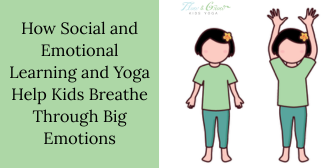
How Social and Emotional Learning and Yoga Help Kids Breathe Through Big Emotions
by Kane SEO April 14, 2025 4 min read
In classrooms and communities around the world, educators and parents alike are placing a growing emphasis onsocial and emotional learning. And for good reason: helping children understand, manage, and express their emotions in healthy ways is just as critical as teaching them to read or do math.

Power of Yoga for Kids: How It Helps Them Grow, Focus, and Thrive
by Kane SEO March 25, 2025 5 min read
In today’s fast-paced world, children are often exposed to stressors from a young age, whether it’s academic pressure, social challenges, or the overwhelming influence of digital devices. This can impact their physical, mental, and emotional well-being.
Ultimate Kids Year of Yoga Bundle
bundlespricey-contentdigital-resourcesearly-childhood-yoga-mindfulnesselementary-yoga-mindfulnesskids-yoga-resourcesmiddle-high-school-yoga-mindfulnessseasonal-yogayoga-cards
Ultimate Kids Year of Yoga Bundle
5 reviews
5.0 / 5.0
(5) 5 total reviews
$45.00
Ultimate Kids Year of Yoga Bundle
5 reviews
5.0 / 5.0
(5) 5 total reviews
$45.00
Kid’s Sun Salutation Yoga Cards
digital-resourcesearly-childhood-yoga-mindfulnesselementary-yoga-mindfulnesskids-yoga-resourcesliteracyunder-15yoga-cards
Kid’s Sun Salutation Yoga Cards
3 reviews
4.33 / 5.0
(3) 3 total reviews
$10.00
Kid’s Sun Salutation Yoga Cards
3 reviews
4.33 / 5.0
(3) 3 total reviews
$10.00
Yamas and Niyamas: Successful Relationships with Self & Others (tweens and teens)
pricey-contentdigital-resourceskids-yoga-resourceslesson-plansmiddle-high-school-yoga-mindfulnessmindfulness
Yamas and Niyamas: Successful Relationships with Self & Others (tweens and teens)
2 reviews
5.0 / 5.0
(2) 2 total reviews
$49.00$55.00
Yamas and Niyamas: Successful Relationships with Self & Others (tweens and teens)
2 reviews
5.0 / 5.0
(2) 2 total reviews
$49.00$55.00
